#glitchhiker
Explore tagged Tumblr posts
Text





Top 5 games 2023
5-Pikmin
4-Slayers X: Terminal Aftermath: Vengance of the Slayer
3-Glitchhikers
2-Inscryption
1-Hypnospace Outlaw
#Pikmin#Slayers x#glitchhikers#incryption#hypnospace outlaw#hypnospace#leshy#zane lofton#leshy inscryption#leshy scrybe of beasts#daniel mullins games#jay tholen
54 notes
·
View notes
Text




Glitchhikers: The Spaces Between
14 notes
·
View notes
Text
I keep forgetting or not having the energy to do the next one of these. It's going to be two in one again, this time for Glitchhikers: The Spaces Between and Vengeful Heart, which are the two "wokest" games I've played in a while (in a good way).
Glitchhikers is the only thing that's ever given me a dialogue option to declare the concept of the hero's journey to be an act of colonialism (we make fun of Campbell on this blog, and also Jung while we're at it), and Vengeful Heart is probably the most openly revolutionary thing I've played since A Bewitching Revolution (which is also great and you should give it a try).
I played the original Glitchhikers over a decade ago when it first came out. It was only like 15 minutes to go through it once, but it was the exact right thing I needed to see at that exact point in my life, and it's still one of my most memorable experiences with a game ever thanks to that. The new remade and hugely expanded version didn't quite do it for me in the same way, but it was still interesting and had some stuff going for it.
It's very much an experimental art game experience and not something big on gameplay, and it can be a little clunky or frustrating to interact with sometimes as a result. The park section in particular was mostly just annoying for me rather than me getting much out of it.
It can also be kind of on the nose with some of the dialogue and the messages in it, and some of it left me feeling like yeah I've seen multiple posts about this on Tumblr except they expanded on the idea with a thousand more words and it led to a bunch of discussion that added a lot more to it.
When it gets stuff right I really like it though. The train segment of the game avoids those problems entirely for the most part, both because it's a fixed path that makes navigating it a lot easier and because you run into each character multiple times. That latter thing is particularly important because it lets them flesh out the conversations a bit more and spend more time with each idea or theme, which it really benefits a lot from.
I think the final airport section was probably my second favorite. It's a bit tedious wandering around the empty space, and it's kinda blunt with its message, but it did a good enough job presenting the idea that how things are framed and structured matters for how we perceive and think about them, whether it's architecture or stories or ideas. It's a very "I see what you did there" way to wrap things up, but it works.
And then Vengeful Heart is just good. It's a postapocalyptic cyberpunk dystopian VN that manages to be appreciably worse than the way things are in the real world but not by so much that it's not immediately able to be related back to real life. And while the setting and situation are pretty dire, the story itself is about disempowered people joining together to work to do something to change it. Not without struggles and loss along the way, and not with a universally happy ending where everything is magically fixed, but with hope for their actions and sacrifices leading to continued change and improvement in the future.
They absolutely nailed the PC-98 aesthetic better than I've seen anyone do it in a while, and it feels like someone could've made the artwork 30 years ago. A lot of the music is pretty good too and sets the tone well.
Its biggest strength is its characters though, which is always a good thing in a medium and genre that relies so much on them. There are strong women and PoC and queer people and disabled people and student activists and working class union members and more all working together, both learning from each other but also having conflicting ideas and motivations at times, and of course the evil billionaires and militarized cops and private security you'd expect from the genre too. I really liked how a lot of them were handled, and I kept thinking about some of them for days after I finished the story, completely unprompted.
I could see myself going back through the train section of Glitchhikers now and then to meet different characters and see what they have to say, but Vengeful Heart is the one I expect to end up fairly high on my list at the end of the year, and I'm really looking forward to whenever they finish the next thing they've been working on.
2 notes
·
View notes
Text
Song: Circles Artist: Devin Vibert From: Glitchhikers
Listen on Youtube:
youtube
#Glitchhikers#Devin Vibert#archived song#closed vote#video games#video game music#music poll#audio poll#Youtube
196 notes
·
View notes
Text
Intro Post!
Since I never made one, here's one now!
Hello, you can call me Oat!
My pronouns are He/it/she, I am a transgender aroace man, and the host of a traumagenic system. I the Mama of @small-gotham , but please do not ask me to be your cg! I am a minor!
You are free to use any gifs I make with proper credit to me., but please do not reuse my DNI banner!
My stimboard requests are open! I will do both agere and non-agere boards! I will also try to do fandom ones, but I am unlikely to do ones for characters I don't know. Below the cut are fandoms I will absolutely not do!
About me and DNI below cut!
DNI
Blogs with ANY NSFW/ddlg content
Anti-neopronouns/lgtbq
Anti-age regression/pet regression/age dreaming
Proship
Pro-ED/SH
Endogenic/pro-endo systems
Racist
Sexist
Anything else bad
Things I Like!
Rabbits, My Little Pony, cooking and baking, acting motherly, reading, sewing, stuffies, cows, and snails! <33
Fandoms I Will Not Make Stimboards For (No hate, I'm just uninterested in them!)
Any real people (actors are fine)
DSMP
Good Omens
Harry Potter
Heartstopper
Rick and Morty
South Park
Sanders Sides
Fandoms I Will Always Make Stimboards For!! I Love These!! (Honestly if you know any of these PLEASE talk to me about them!! I know a lot of them are very unknown and I wanna know more fans!!)
Animal Jam
Batman (probably, depends on what source)
Bloons Tower Defense 6
Bluey
Broken Age
Cattails
The Cave
Club Penguin
Cyberchase
Dishonored/2
Don't Starve/Together
The Elder Scrolls V: Skyrim
Ferris Bueller's Day Off
Firewatch
Frog Detective
Ghost of a Tale
Glitchhikers
The Good Place
Later Alligator
Little Inferno
Martha Speaks
Moonlighter
Moshi Monsters
My Little Pony FiM
Night in the Woods
OneShot
Pup Academy
Purrfect Apawcalypse series
Purrgatory
Road 96
Root
Shelter/2
Slime Rancher/2
Spiritfarer
Studio Ghibli moveis (Especially Nausicaä, Kiki, or Arietty)!!
Subnautica
Tangled/Tangled: The Series
Warrior Cats
Wings of Fire
Word Girl
The World Next Door

8 notes
·
View notes
Text
I had literally been thinking about him last night too... When you start up the first Glitchhikers game you catch the end of Pinky's Dream on the radio...
0 notes
Text
Meeting 05 - Vožnja/Ride
Skupaj se zapeljimo se v zadnjo srečanje tega leta! V torek bomo vozile_i starega Yugota, “ne igro” Petrit Hoxha ter na poti pobirali Glitchhikerje. Oba dela se ukvarjata z nočnimi vožnjami po liminalnih okoljih, transnim občutkom samote na cesti ter objekti, ki se nam vtisnejo v spomin, kot zanimvi spotoniki ali pa brutalistični spomeniki. Vsaka igra vzame kakšnih 10-15 minut, da se jo “dojame” in nobena od niju nima konca. Po srečanju pa seveda vabljeni na kuhančka/vročo čokolado, da se za letos poslovimo ter podebatiramo plane za naslednje leto :)
Povezave:
https://silverstring.itch.io/glitchhikers
https://petrithxha.itch.io/yugo
ENG
Let’s drive into the last meeting of this year! On Tuesday we will drive an old Yugo, a “non-game” from Petrit Hoxha and pick up Glitchikers along the way. Both works deal with liminal night time car rides, trans-like feeling of loneliness on the road and objects that will live rent free in your mind as either queer compatriots or brutalist monuments. Each of the games takes around 10-15 minutes to “get it” and neither of them have an ending. After the club we're heading out for some gloog/hot chocolate to say goodbye and figure out plans for next year :)
Links:
https://silverstring.itch.io/glitchhikers
https://petrithxha.itch.io/yugo
0 notes
Photo

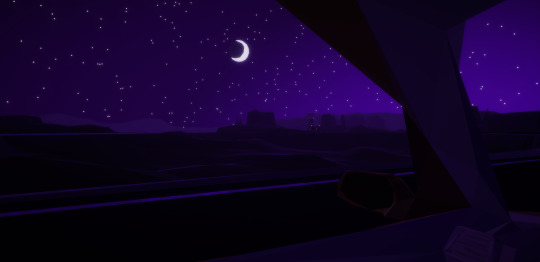

Passing stars / Canyon dives / Lone tree.
(Game: Glitchhikers: The Spaces Between)
8 notes
·
View notes
Text
EVERYONE PLAY GLITCHHIKERS RIGHT THIS SECOND
13 notes
·
View notes
Photo
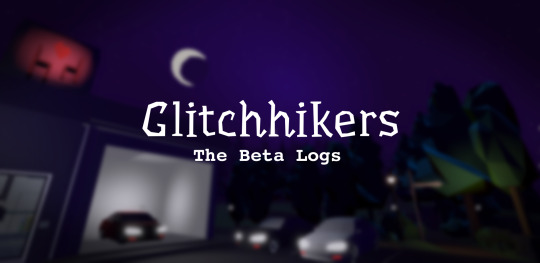
Glitchhikers: The Beta Logs
Around late Fall in 2021, I volunteered to beta-test the Glitchhikers remake, Glitchhikers: the Spaces in Between. I should note that this wasn’t a job, I didn’t get paid, and all I was asked to do was give general feedback on the game after playing it through. Really, it’s a kind of beta-test that functioned more as a mechanism for generating hype than actual beta-testing for a paycheck, which, I admit I have some quibbles with, but hey, I signed up to do it anyway.
This fact of beta-testing means I can’t recommend the game in a normal issue, but it did give me a fair amount of thoughts about the game, so I wrote ‘em down, locked ‘em away, and am now releasing them to the wild now that the game is on the market. I should stress that once again that this is not a recommendation or a review (as if I did those, hah), and it is only my thoughts on what the game looked like still in beta. On with the show, and spoilers abound.
I’m talking to a dragon, or least what used to be a dragon. It used to be one of a legion, proud and powerful, a species with technological might in living flesh, and now, having escaped the end slated for the rest of its kind by packaging itself into data and connecting to the human internet it is utterly alone. As it tells me of the things it has lost through in having to downgrade to our much more primitive technology, it notes that one side effect is distortions, its voice stutters through that last word – and an overhead voice chimes in, telling us what the next stop is. Because the dragon and I, we are two passengers on a communal train, headed somewhere in the night.
I covered the original Glitchhikers (now termed Glitchhikers: First Drive) in my 2020 Hallowe’en Rapid-fire Recs issue, but for the uninitiated, it is a short, experimental game about the of experience driving down a near-empty highway at 12AM and talking about life, the universe, and everything with the various hitchhikers you pick up under the surreal weight of the night. Glitchhikers: the Spaces In Between expands upon that experience, both in adding more fidelity and detail to that specific night driving experience, and by having 3 other journeys that try to bring about that state of mind – The Railway, The Path, and The Terminal.
For the most part, they succeed quite handily. I likely have the least to say about The Highway, having played the original game several times over. What I can say is that they’ve put effort into overhauling the experience on multiple fronts (I replayed the original game after I finished beta-testing). The landscapes you drive by are given much more variance in terms of the natural facets you see, and there are visible changes in the elevation that you’re driving at, too. It’s also just a huge quality bump from the original, I was just shocked at how rough and low-poly First Drive was upon replaying it. Replaying First Drive also showed that the visuals weren’t the only things retooled. The first hitchhiker you meet in Spaces is the same as the one in First Drive, and you do have a slightly different conversation with her, though the essential bits from the original, such as her childhood make-believe with the stars, are still there. (Another detail I like is how the occasional other vehicles will wink in and out of existence on the road as you blink your tired eyes.) You’re still given the choice to exit into the city or keep on driving at the end, and after you complete your first journey an infinite drive mode is unlocked, which is all I ever needed, thank you.
Along with The Highway, The Railway is the only other journey available to you from the start, and it was the one I was the most excited for, because I am huge fan of trains as a transitive space to journey in. So much that a few years ago I briefly drafted up a Tabletop RPG about riding a train, viewing the sights, and having conversations with your fellow passengers. I still think that a Tabletop RPG is a great medium for such a communal activity, but until I pick up the idea again, The Railway serves as an excellent way to satisfy my cravings. Compared to the fleeting interactions that you have with the hitchhikers, with The Railway everyone is on the same train, so you can have progressing conversations with the other passengers as you take in the various sights.
In a manner that aligns with how the player is stationary inside their vehicle on The Highway, freeform movement with the WASD keys does not exist on The Railway, nor any area in the game, aside from The Terminal, which we’ll get to. Instead, there are various hotspots that the player can click on to move to in each room, and progress towards the front of the train. This movement system surprised me at first, since it’s rather unconventional, and I doubt the designers couldn’t just program in traditional WASD movement. This hotspot method is one that de-emphasizes the player’s movement around the train, and instead puts focus on the movement of the train along its tracks.
As with The Highway there’s a sort of role-playing choice, too. As you walk forward in the train cars, there’s an option to get off at whatever stop the train is at instead of continuing on your journey. Perhaps you found a place you wanted to lie low in for a while, or maybe it was your destination all along. There’s enough detail about the stops to make it a meaningful decision, as the overhead announcer (The Railway’s equivalent of The Highway’s late-night radio program) gives a description of wherever you’re headed. At one point when I was on The Railway, the overhead announced that we were approaching a town – I can’t remember the name – that was left in ruins after the practices of a powerful few drove it into the ground, and stated, simply, “We won’t be stopping there.”
The Railway is also where I once again met the Star Woman from The Highway, who appeared as the first hitchhiker in every other journey since, as a way of establishing a baseline of social interaction for your journeys – and to make it clear that you’re able to meet the same hitchhiker across journeys, if it doesn’t happen naturally. The Railway also plays with surreality as a backbone of its structure. Given how you talk with the same people multiple times, instead of forcing you to meander back and forth in the train cars to have your subsequent conversations with a passenger, in The Railway you’re always moving forward, to the front of the train, where the other passengers lie for their next conversation after you finish the preceding one. It makes movement more fluid, and it also adds a sense of forward permanent progress that mirrors your familiarity with the other passengers. Also before you move onto the next group of train cars, you enter one that’s an endless dreamscape completely separate from the movement of the train and the outside world, which works as an introspective pause between conversational rounds, and is just breathtaking and a lovely surprise the first time it happens. Alas, there is not a matching Infinite Ride mode for The Railway. A man can dream.
After completing the The Railway, I moved onto The Path, because that was the order in which they were listed to me, and I am conformist dweeb. Unlike the vehicular basis for The Highway and The Railway, The Path is a walk through a park at night, accompanied by one’s iPod playlist, which is another wonderful fantasy game space, because if I ever tried to take a walk in a park at night with my earbuds in, I fear I’d find myself in a schlocky horror movie. The playlist is alternates between soundtrack songs a mini-podcast that talks about the wonders of life, and aside from occasionally coming across other hikers scattered across the area, you’re left to your thoughts and your playlists as you wander amongst its various sights and structures.
Though perhaps wander isn’t quite the right word, as though The Path forgoes The Railway’s hotspot movement system, it isn’t quite free-roaming, either. Instead, the player can only move forward or backward along the literal walking path as if tethered to an invisible rail. This emphasizes that it is, in fact, a path – your journey is not one of uncharted exploration, it’s walking a route along a local park with some nice sights. There is also an auto-walk key if you get tired of holding down W, which I used liberally.
Even though you’re on a rail, being in a park means that you do have means of deciding where to go along its many paths, and the designers found a way to deal with the directional ambiguity in their unique movement system, too. Whenever approaching a fork, a trail of light will appear and go down whatever path you’re set to go down, giving you time to course-correct. (Aesthetically, it’s fitting that said trail looks like the imprints of headlights in long exposure photographs). Aside from that, there’s not much I can say aside for the fact that the various park decorations are wonderfully varied with a lovely use of space and height, along with some more surreal pocket dimensions. The park is also a location anchored relative to the rest of the journeys, as at a high point on the edge of the park one can look out to see The Highway and the city that lies at the end of it.
Finally, there’s The Terminal, the final journey and a bit of a black sheep, as for it, Glitchhikers finally gives into movement convention and allows for free exploration with the WASD keys inside of a (near) empty airport where all the flights have been delayed. Which – okay, alright, if you are also a conformist dweeb, then the order of the journeys has a progression of more and more player direction, which is nice, but the use of traditional movement tech when everything else has been almost stubbornly experimental, whether through necessity or design, suddenly recasts a sense of doubt about the movement tech of the preceding journeys. If they could’ve done WASD all along, why didn’t they? Which is not to say there isn’t a point to using variant movement tech (I think my previous commentary shows that there is), but that the switch back to the Same Old is somewhat jarring. (Of course, this is where the fact that this is a beta log comes in – maybe the final game will go WASD. I doubt it, but I could be wrong.)
Regardless, going off of the freeform movement in The Terminal – it’s a bit rough in a way that the other, more limited movement schemes aren’t. This isn’t a deal breaker, it’s not worse than, say, a good itch.io Jam game, only that it makes it harder to really immerse one’s self in the game space to be able to embrace the nighttime mood that is its lifeblood. This immersion hindering movement is compounded by the presence of these… grey spheres with varying rings of colour around them (I should note that a rainbow trail of your movement follows you in The Terminal, although my description makes it sound much more gaudier than it its). These spheres, compared to the casual surreality of the past journeys, are overtly… game like. They look like power-ups, and they functionally act like them, too – upon passing through one, you speed up and occasionally are catapulted into the air in a display of physics I don’t really understand, and then all of the other little spheres gets an extra ring of colour.
The Terminal’s wide expanse is about the time you spend in stasis, when you’re left waiting with nowhere to go. With The Railway and The Highway, you had a destination, and with The Path, you were wandering around the park because you liked what it had to offer, it was journey as destination in the simplest form, but with The Terminal the very first thing you hear is a news broadcast (The Terminal’s equivalent of radio program, overhead announcer, or podcast) that all flights have been delayed, indefinitely. You are then left to wander around the premises, killing time. And, admittedly, here the low-poly style of Glitchhikers flounders a bit – it’s always the weakest when trying to express manmade structures – The Terminal is a building of dull blues save the occasional news broadcast, and the architecture is rough in a way that looks unfinished and amateur instead of charming. I can see why the designers might add in the spheres as a way of adding variety to compensate for the much less compelling setting, but I have enough belief in their clarity of vision from the rest of the game that I feel like there surely could’ve been another way to go about it.
All of these factors aside, I want to stress that I do see the point in The Terminal’s divergence from the rest of the game. Aside from the fact that experimentation is good and what birthed First Drive, The Terminal is still about a slightly surreal in-between experience, just a much less aesthetic and more lonesome one. And that change from traveling with a purpose, from talking to many other traveler (in The Terminal there’s just one), does take chops. It’s just that it seems to capture the experience in a less compelling many than any of the other journeys – though perhaps my perspective is a bit biased, as earlier in the year I played the itch.io game Interminal, which tried to express that same experience to greater success. This is not a dig at Glitchhikers, which has an overarching purpose to its terminal beyond just replicating experience, and Interminal has a different aesthetic style and time of day that plays better to the location, but the comparison was not a flattering one.
As mentioned before, The Terminal has only one traveler, once again Starkid Lady, who appears at the bar after you tramp around from news broadcast to news broadcast. This makes your conversation with her denser, even employing a conversational loop wherein your dialogue choices do not move onto a new set of options unless you specifically choose it so. This allows for a more one-on-one conversation that you get anywhere else, which is a nice bookend of the solitude wandering that you engage in before it.
In addition to all of these places, there’s also the first one you see: The Stop. It functions as a physical journey select and what-hitchhikers-have-I-met menu in the form of a rest stop. At The Rest Stop, you can see the various cars that represent The Highway, Infinite Drive, and the Classic Mode unlocked after playing through each journey once which is a strict faithful remake of First Drive. Looking around, you’ll also see the train car that takes you to The Railway, the lamp-lit, thrush-surrounded, trail leading to The Path, and the crossing sign that takes to The Terminal. On the other side is The Stop itself, where you can see which hitchhikers you’ve met and talk to the Clerk to get information about the game. It’s a lovely way of immersing the player into the game’s world.
Also, because The Stop has the most prominent use of the Glitchhikers logo, I’m going to talk about how good it is. The logo is taken from isolating the back-to-back capital Hs in the title, with a heart in between the two of them, literally marking the space in between the two parts of that compound word. But in The Stop, the logo is one of lit signs they have, and as lit signs are wont to do, parts of it are blown. Specifically, the upper stems of each H on the inner sign, transforming them into two chairs facing each other, which is just perfect.
Of course, the locations are only part of Glitchhikers, the other component being the hikers themselves. I only played each journey once in order to not spoil the final game with beta-redundancy, so I only met 10 hitchhikers (aside from Star Lady I had another repeat), but among them I had a wide variety of conversations, from a grieving woman to scientist in awe of the universe to a nihilistic alien child. And these conversations do display a shift in focus from First Drive – the specificity to issues of the real world. Whereas the conversational topics of First Drive trended broadly philosophical, like the scope of the universe, or personal to character’s lives and childhoods, The Spaces In Between drills specifically to the systems of the world: one hitchhiker who debates the ethics and ramifications of technological progress cites how A.I. can replicate racial profiling bias, and another directly calls out Capitalism for stealing away her time to exist as a person and more than a cog in a machine.
This is a bit jarring coming so directly from a video game, but at the same time, it’s necessary change. First Drive was released in 2014, but in 2021 the concept of having deep philosophical and existential conversations about the world is impossible without looking at it in the eye and naming what we see. However, at times, it felt uncomfortable to discussing these topics in the game space, even when I was selecting dialogue options I legitimately agreed with. This might be an unintentional symptom of being on social media, but admittedly, sometimes the frequent references to leftist issues felt like the game was trying to flash its political-philosophical credentials. As it is, politics, and anything dealing with the seamy, seamy issues of the world is something unbelievably complex and nuanced, which is something that games have often struggled with for as long as they have existed – and unlike just wondering about the nature of our existence in the impossibly grand scale universe, it’s much more hefty and loaded, because it deals so much more with the injustice in the world and people fighting to be recognized as human. But occasional awkwardness aside, I stand by the notion that this was the right choice – much better to awkwardly grasp at the truth than try and create an ‘apolitical’ game that ignores something integral to its concept and themes for the sake of keeping the boat steady.
Or, perhaps, maybe the occasional bristling against the anti-capitalistic themes was the mild hypocrisy? I did volunteer to perform free labor on a whim. I’m not accusing the team because I knew it was going to be unpaid, and again, the only thing ‘required’ was a general feedback form instead of the active bug-seeking work the actual beta testers I hope they have are doing. It is, as I said in the intro, more of a hype campaign. But at the same time, it’s not something I can ignore when examining the game’s leftist and anticapitalistic themes.
Aside from the specificity of subject matter (part of which also comes from having a wider swathe of hikers in general), another thing about the hitchikers is that they essentially don’t have a fourth wall. On two different occasions I’ve chosen a dialogue option with my head in the game space, only to be pinned under a metatextually aware response I didn’t see coming. The first time was on The Path, talking to the mourning woman who I had met earlier on The Railway. She asked me what I was planning to do after this, and I figured she’d meant walking in the park. I don’t remember what I answered, except it was casual, and to that she questioned my ability to throw off the weight of the night so easily, saying, “Do these journeys not linger?”
The other time was elsewhere in park, where I was talking to a group of floating crystals about the impact of human on the environment, and they asked “Are we life?” I answered yes, figuring that by we they were referring to themselves as some sort of hive mind, and referencing their digital-looking nature. They challenged me on that, stripping back the curtain and calling every hiker a set of planned responses to designated stimuli. In both moments, I answered an extradiegetic question thinking it was a intradiegetic one – but strangely, I don’t feel tricked. The ambiguity of language is always in play when you’re talking to real people, and for some reason, exposing the game as a constructed reality only emphasizes it as a sort of pocket dimension one can journey to, from time to time.
As far as my beta-testing playthrough went, Glitchhikers: the Spaces In Between was a wonderful experience that did a solid job of expanding on the core experience of the original game. It wasn’t perfect, no, there were stumbles, but even where there were cracks you could see legitimate intent in saying something outside of the aesthetic experience even when that aesthetic experience was pretty damn good, and I think that’s worth a lot. It is very much the remakequel I was hoping for.
#Video Games#Indie#Talkin' 'Bout Tiny Games#Glitchhikers#Glitchhikers: the Spaces in Between#Essay#Writin' on Tiny Games
11 notes
·
View notes
Photo


im so fucking happy this game came out
#glitchhikers has had a permanent place in my soul for years#so it getting a full face-lift/sequel treatment with new ways of traveling is just#so good#im so happy#glitchhikers#glitchhikers: the spaces between
10 notes
·
View notes
Text
Top 10 games I missed in 2022
This was in many ways a transformative year. Or maybe that’s an overstatement and 2022 was end of an era. It followed a long term trend of me playing games less and less. I haven’t played a game on Steam since January. With that a maybe even some time prior I stopped paying attention to new releases. Until yesterday. Yesterday, I succumbed to the calling of Steam winter sales and visited my wishlist. I noticed that it was slightly messed up, because some of the games got released. After that I spent several hours looking for new releases and here we are. I admit It’s different, because many of these games are titles I’ve only found out about them being released.
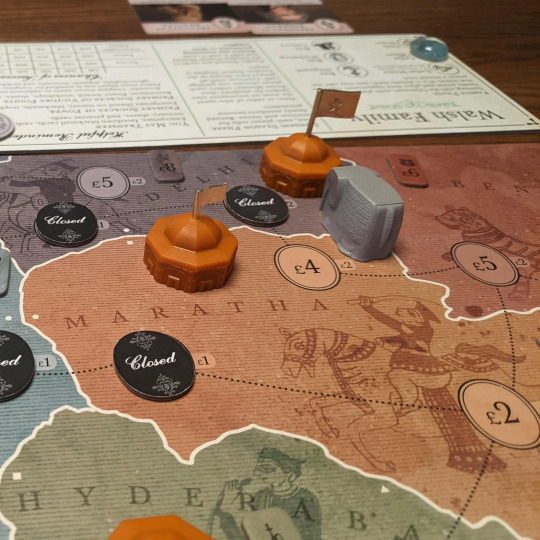
Ofc, this year was massively, more than any of the previous years, influenced by board games and board game media. But getting around to actually buying some board games, I found out that the new hotness is rarely what I’m after. So, there are only 3 board games from this year I would like to own and 2 more I would like to try and write about (Stroganov’s take on colonization of Siberia could be made way better if it took a simple lesson from my n. 1 game). The three board games differ from each other a lot and video games on the list are reasonably diverse too. There are narrative experiences, Metroid and Castlevania inspired games both with jumping and without and free games I haven’t got time to try out yet. I also have one honorable mention: Victoria 3. Normally, this probably would make the list, but I don’t know enough to be excited and I’m still happy with my older Paradox games and I don’t need new ones (also, I know that Victoria 3 is beyond capabilities of my half-dead laptop).
10. Maptroid: Worlds
This is a commercial follow-up to a free game, you can still find online (not sure if flash?). It looks terrible, music probably does its job. It’s also an original and interesting take on the genre of Metroidvanias. It requires at least basic knowledge of the genre to get it and to appreciate it too. Because in Maptroid, you play on the minimap only. You explore and move around. The pacing is fast and that makes it fun. The commercial version promises more and that’s exactly what I want. Also, It’s only 2 bucks and some change.
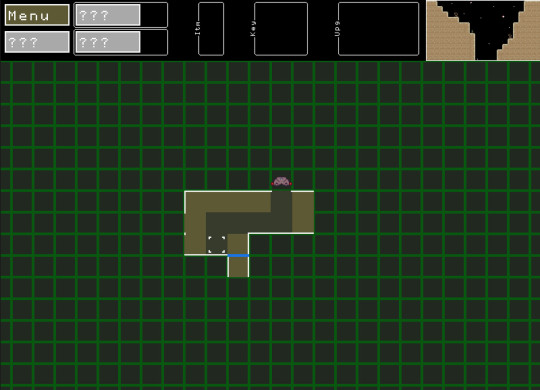
9. Infernax
At first this looks like a straight clone of Castlevania but there’s more to it. There are choices and different endings. If you watch any footage of Infernax and like the genre of non-linear platformers you know the game is fun. It looks difficult with good controls and smooth movement. The fiction full of crosses and demons is something I can appreciate. The look is appealing too. A must play in a surely coming year of non-linear platformers.
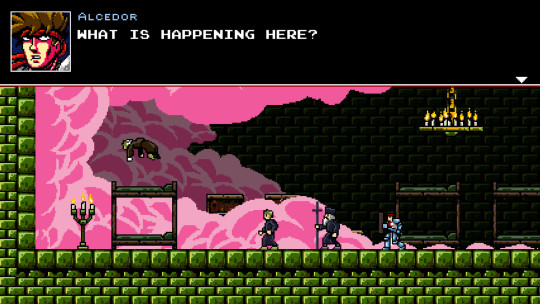
8. Haiku the Robot
The third and final game of jumping and exploring on this list. Haiku is by far the most stylish one with beautiful sepia tones and detailed modern pixel art. It also looks like the most expansive one with many bosses, interesting puzzles and original lore. I’m afraid it might be too difficult as Hollow Knight seems to be a source of inspiration here. But without this baggage it looks like a fun and tight addition to the genre. One more thing, I like haiku.

7. Three Sisters
The first board game on the list is a heavier than average roll and write about tending to vegetable garden. The main reason this is here is the production. These warm pumpkin colored dice are just attractive and the whole game feels warm and welcoming in the similar manner. The game itself is about rolling dice and using them to tick boxes and form combos. Or if you go for the theme, and I think you should, planting seed, harvesting fruit and veggies, crafting in your garage. And that might be quite lovely when rainy and you can’t manage your garden for real.
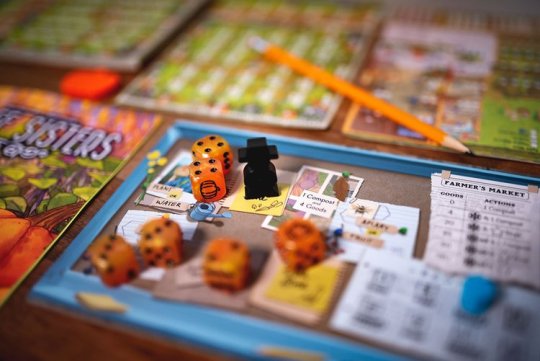
6. Sunset Shift
This free game is about collecting and disposing garbage at a small private island. I watched some footage of it and it looks right up my alley. Basically, you drive around and the other friend is talking to you via radio giving the whole thing subtle story beats. I also enjoy games with either social or environmental message and this one seems to have both.
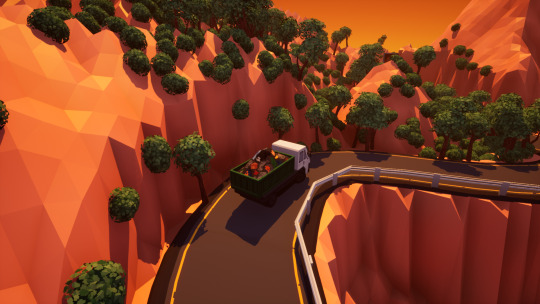
5. Glitchhikers: The Spaces Between
The original free Glitchhikers was one of my favourite cruising games. In it you drive on a highway while having random dialogues. This one expands it in all directions and adds many new environments and means of transport. I wonder about the message. Is it more than just more volume? Anyway, because of the original this one is on my bucket list too. Also, it’s the first game with no green or greenish pictures.
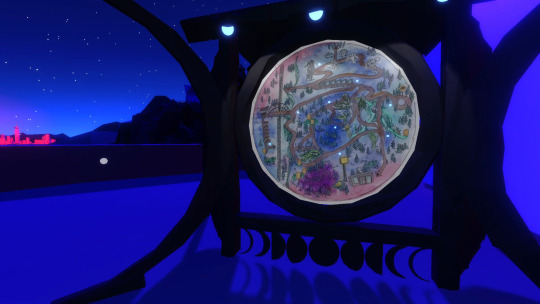
4. Citizen Sleeper
Frankly, I don’t quite understand what Citizen Sleeper is supposed to be. It’s a cyberpunk science fiction rpg controlled by dice, so there’s this tabletop element. Also, it seems to be focused on social issues, equality and such. You’re a working person and that reminds me of Cart Life, one of the greatest games ever. Jump Over the Age also made In Other Waters, an exciting UI experience I haven’t played yet but It’s one more reason to be interested in this game.
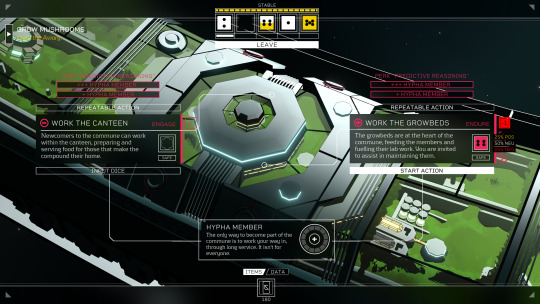
3. Village Rails
It’s a small and crunchy card game about building tracks with bucolic tones. The second part of the Village series from Osprey and designed by Matthew Dunstan with Breet J. Gilbert in a little unassuming box with a pleasant blue frame. It got praised by all of my board gaming sources including Dice Tower, Shut Up and Sit Down and Board Game Barrage. The game’s almost a filler but the combination of different goals and a special puzzle makes all decisions crunchy. For me it looks like a kind of game I would enjoy.
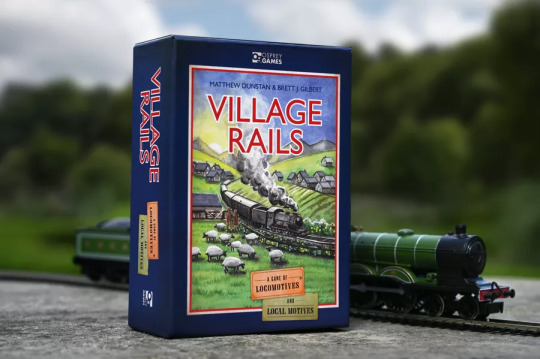
2. Roadwarden
Out of the green and into the brown. Roadwarden is a game I’ve been interested for a while. I think it does something interesting and that the devs limited themselves well to make a bigger game. The illustrations in this game look great too. I feel like I might enjoy its bleak fiction too. Being this highwayman and delivering messages, burning bodies sounds mundane, but also super atmospheric.
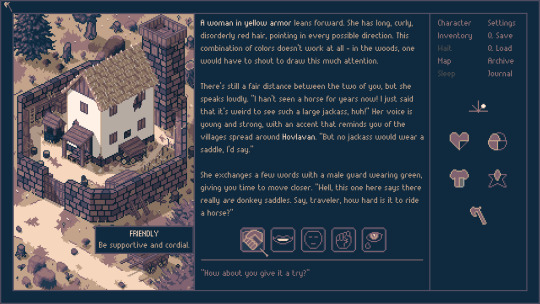
1. John Company: Second Edition
John Company is an unwieldy game from Wehrelig Games and Cole Wehrle of the Root fame. It’s complicated and long and an experience I want to have. I even managed to watch most of the five hours long session of Heavy Cardboard streamed on YouTube. In the game you and other players run the titular company and exploit India in order to get yourself a good retirement. The second edition tweaked almost everything and it looks great with one of the nicest board and components I’ve ever seen. Also, John Company: SE Is clear with its message and criticism of colonialism through its mechanics, something games like Stroganov ought to learn from.

All of the pictures used in this article are either from official sources or posted by the publisher at BGG(Village Rails).
#maptroid worlds#infernax#haiku the robot#three sisters#sunset shift#glitchhikers#roadwarden#village rails#citizen sleeper#john company
1 note
·
View note
Photo

'Glitchhikers: The Spaces Between' Demo Impressions: Food for Thought
Sometimes the best thing to do is to simply let your thoughts wander, as you're going from A to B. To simply wander from A to B as your thoughts go. To think from A to B - alright, it might be time to start making some actual sense. See, I just played the Glitchhikers: The Spaces Between demo, which contains a small slice of what appears to be part remake of Glitchhikers: The First Drive, and part greatly-expanded-up-on experience. But exactly what did I... experience?
Continue reading
4 notes
·
View notes
Link

We've got a brand new Starlight Car up for patrons, where Solon and Walker talk to Silverstring Media about wrapping up Glitchhikers: The Spaces Between and debut a new song from the game!
If you'd like to listen now, it's just $3 a month at http://patreon.com/vgcc, or we'll release it for free next week!
#silverstring media#glitchhikers#glitchhikers: the spaces between#interview#podcast#vgcc#video games#video games podcast#video game choo choo
5 notes
·
View notes
Text
When you boot up a game and it has a "Hey man, this game could make your mental worse. Just giving you a heads up that you can stop playing at anytime." Thats when you know its the good shit.
1 note
·
View note
Photo

Another year… and this time I’m not a month late.
(Games: Peak Bleak Blues and other moods - Isle of the Dead, Dèpanneur Nocturne, ZONES - Orogen Myths, NUTS, Joanie, Sacramento, Everything, Routine Feat, Glitchhikers: The Spaces Between, The Stanley Parable Ultra Deluxe, Pebble Witch, co-open, Cloud Gardens)
#Art#Peak Bleak Blues and other moods#Isle of the Dead#Dèpanneur Nocturne#ZONES#Orogen Myths#NUTS#Joanie#Sacramento#Everything#Routine Feat#Glitchhikers#Glitchhikers: The Spaces Between#The Stanley Parable#The Stanley Parable Ultra Deluxe#Pebble Witch#co-open#Cloud Gardens#Anniversary
9 notes
·
View notes